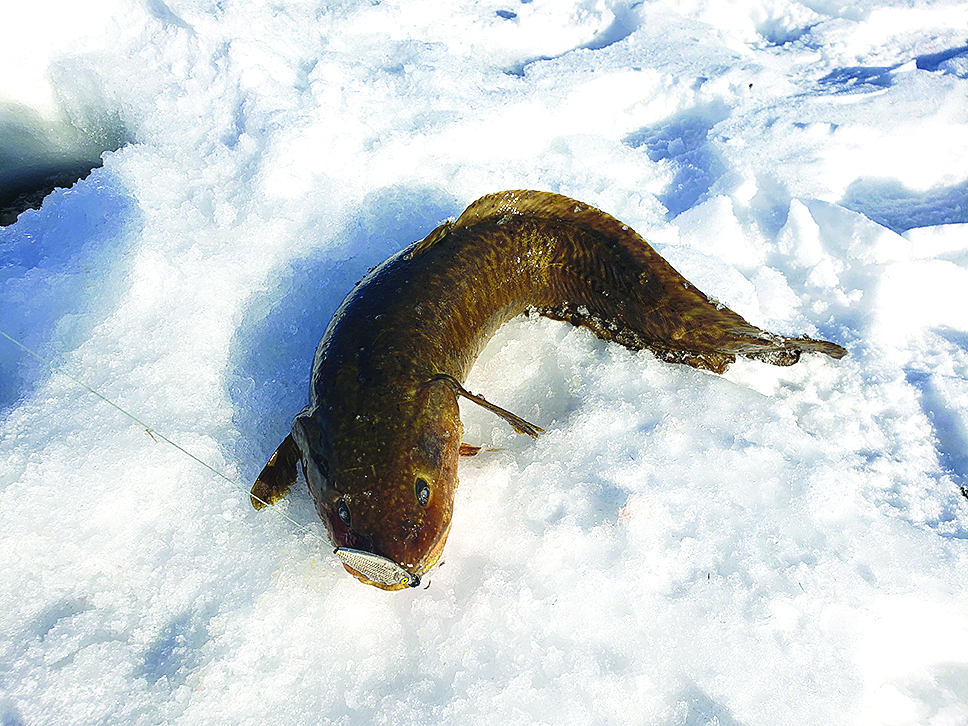It was a bluebird day in February, and I was sitting on a fold up chair enjoying the mid-winter sun while fishing for trout on Lake Superior. I’d been jigging my spoon just off the bottom, hoping for a lake trout to appear on my Humminbird flasher, but nothing was showing. As I kept fishing, a mark finally appeared on the bottom. It wasn’t acting like a lake trout, but the flicker of colour on my screen had me at full alert. I dropped the Zzinger in-line spoon to the bottom and on the upstroke felt a strike.
Fish On!
The rod was bent over well, but this fight was different. It felt more dogged than a lake trout and lacked the power runs. With steady pressure, the fish came up and when its head came in the hole, I could see what was going on. It was not the face of a trout. The hook was latched onto the mouth of a burbot and I slipped it onto the ice where it wriggled in protest. There was a time when this catch might have elicited a groan or a derogatory remark. However, like many modern ice anglers, I’ve come to appreciate burbot and the delicious, seafood-like quality of its flesh. This one was a perfect eater of about 4 pounds, so it was dispatched and laid on the ice. It would become supper later that night.
The burbot is a fish of many names. Depending on where you live in the world, they are called mariah, loche, cusk, freshwater cod, ling, eelpout or—my favourite—the lawyer. Burbot are native to the subarctic regions of the northern hemisphere and thrive in cold water. Burbot comes from the Latin word barba, which means beard, and refers to the single chin whisker, or barbel, they sport. Burbot are a true freshwater cod and they look the part, with soft rayed fins, slippery skin, and snake-like movements. The mouth of a burbot is wide, with both jaws having many small teeth. Burbot have small fins relative to their body size and can’t abide by strong currents. In rivers, they are forced to hug the bottom.

Most anglers don’t tangle with burbot in open water, but when the ice forms, they can become a common catch in lakes where they are plentiful. I’ve often caught them when fishing for walleye or lake trout over the years, especially when there is live or dead bait involved. The other thing that happens in the dead of winter is the burbot spawning period. It seems to happen around February in northwestern Ontario, but it can fall any time between January and March. Burbot group up in certain areas in a lake, and if this is where anglers are fishing, the bite will be hot. Burbot group up into what’s called a “spawning ball,” and this can put a lot of fish into a very small area. Another thing that’s interesting about burbot is they are most active in the dark. Anglers who really want to target these fish will sometimes go at night.
Burbot can be caught on any presentation that will catch a trout or walleye. I’ve had them take white tube jigs, a variety of jigging spoons, jigging Rapalas and hair jigs. They seem especially attracted to lures that have some glow or UV component. If you are fishing at night, you should turn up the glow. I’ve also found jigging lures that have a sound component will attract them as well. Spoons with rattles or sonic capabilities, like the Zzinger or BuzzBomb, fit this bill. However, the most consistent way to catch burbot is on a set line with a live or dead minnow. Burbot have a keen sense of smell and appreciate a little meat. Frozen cisco, salted minnows and chunks of sucker when laid on the bottom will catch burbot. Live minnows and suckers will do the job too, although burbot aren’t good at chasing lively bait around. If a minnow or sucker is extra lively, try to use a heavier sinker or lead head jig to keep it in place.
Burbot can be caught at a variety of depths in lakes, from shallow (10 feet or less) to quite deep. Typically, burbot will be caught near the base of drop offs or around mid-lake shoals. They also seem to spawn around flats with low growing aquatic vegetation. An ice angler targeting burbot should focus on depths between 20 and 40 feet. In low light or at night, you can expect burbot to come to the tops of reefs and move into more shallow water.
The best way to clean a burbot is to hang it by the head from a nail or hook. Cut the skin near the base of the head and pull it down with a pair of pliers. Remove the fins off the carcass with pliers or sharp scissors. Then remove the backstraps of the fish by cutting down on either side of the backbone. Some people also eat the belly meat. I avoid keeping larger, older burbot to eat due to the bioaccumulation of toxins. The 3-6 pounders are prime for eating. Burbot meat can be boiled like lobster, fried, baked, or poached. It’s white meat and it’s quite delicious.





